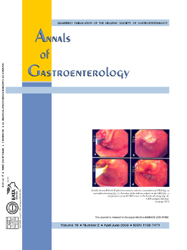Cannulating the papilla from the reverse position. Therapeutic ERCP in patients with Billroth II gastrectomy
Abstract
Therapeutic ERCP in patients with Billroth II gastrectomycan be more difficult, because of a surgically altered anatomy
and requires a very skilful endoscopist. Most endoscopists
recommend the use of a side-viewing duodenoscope.
Gastroscopes should be reserved as second choice
after a failed attempt with the duodenoscope. Afferent loop
intubation is successful in 72-94% of patients. The most
serious complication during ERCP is bowel perforation
(0,7-2%) caused by manipulations through the afferent loop,
while trying to reach the papilla. Selective cannulation and
sphincterotomy of the papilla is safely and successfully
performed from the reverse position (5 to 6 o clock position,
for the common bile duct), with the use of a specifically
designed Billroth II sphincterotome.
Because of the anatomical changes, diagnostic and therapeutic
endoscopic retrograde cholangiopancreatography
(ERCP) is more demanding, in technical terms, in patients
with a Billorth-II (B-II) gastrectomy, as compared to the
procedure in an intact upper alimentary tract. Conceivably
the respective success rate of ERCP is 50-90% and 85-95%.
The endoscopist performing ERCP in a B-II patient has to
consider and overcome the following issues: I) to choose
the appropriate endoscope, II) to intubate the afferent loop,
III) to reach the duodenal stump and papilla, IV) to selectively
cannulate the papilla and V) to perform an endoscopic
sphincterotomy. The whole issue has been addressed by
specialists shortly after the introduction of ERCP in 19681
and endoscopic sphinterotomy in 1973.2 However, interest
in these issues continues to the present and will be discussed
herein.



